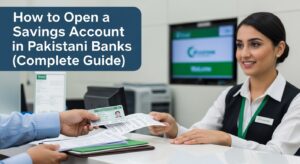Mastering your personal monthly budget in Pakistan for 2025 is a process that empowers you to take full control of your finances, reduce stress, and achieve your most important goals. The journey begins with a clear understanding of your income sources, ensuring you know exactly what you have to work with each month.
This means carefully tracking not just your salary, but also any freelance earnings, business profits, family support, or other regular inflows. By using the lowest monthly income as your baseline, you create a realistic foundation that prevents overspending and helps you stay prepared for leaner months. This approach is especially important in Pakistan, where income can fluctuate and economic conditions may shift unexpectedly.
Once your income is mapped out, the next crucial step is to list and categorize every expense. This involves a thorough review of your bank statements, receipts, and cash transactions to capture both fixed costs like rent, utilities, and school fees, as well as variable expenses such as groceries, transport, and entertainment. Including annual or irregular costs by dividing them across the year ensures your budget remains accurate and comprehensive.
With a clear picture of your spending, you can set specific, measurable financial goals—whether that’s building an emergency fund, saving for a major purchase, or planning for long-term security. Choosing a budgeting method that fits your lifestyle, such as the 50/30/20 rule, zero-based budgeting, or the envelope system, allows you to allocate your resources effectively and stay disciplined throughout the month.
The process doesn’t end with planning; it’s about consistent action and regular review. Tracking your spending daily or weekly, using apps or simple spreadsheets, helps you catch overspending early and make informed adjustments. At the end of each month, comparing your actual expenses to your budget reveals patterns and areas for improvement. Adjusting your plan to account for inflation, changing needs, or new goals keeps your budget relevant and effective.
Building an emergency fund, automating savings, and involving your family in the process further strengthen your financial resilience. By troubleshooting common challenges, like irregular income, forgotten expenses, or lack of motivation, you ensure your budgeting journey remains on track.
With the right tools, practical strategies, and a commitment to regular review, you can transform your financial habits and enjoy greater peace of mind in 2025.
Why Budgeting Matters And How It Changes Your Life
Before you start crunching numbers, it’s important to understand the real value of budgeting. In Pakistan, where prices can change quickly and incomes may be unpredictable, having a budget is like having a map in unfamiliar territory. Many people avoid budgeting because they think it’s restrictive or complicated. In reality, a good budget gives you more freedom, not less—it lets you spend on what you truly value, guilt-free.
- Control Over Your Money: Instead of wondering where your salary disappeared, you’ll know exactly where every rupee goes. This sense of control can be empowering, especially if you’ve ever felt anxious about money.
- Reduced Stress: When you have a plan for bills, savings, and emergencies, you’re less likely to panic when something unexpected happens—like a sudden medical expense or a jump in utility bills.
- Achieving Your Goals: Whether you dream of buying a home, sending your children to a good school, or simply enjoying a family trip, a budget helps you set aside money for what matters most.
- Preparedness for Surprises: Life in Pakistan can be unpredictable. A budget helps you build a cushion for those “just in case” moments, so you’re not caught off guard.
Building a Solid Foundation
The first step in budgeting is knowing exactly how much money you have coming in each month. This is your starting point, and it’s crucial to be as accurate as possible. Overestimating your income is one of the most common budgeting mistakes. Always use conservative estimates to avoid running short later in the month. If your income is irregular, create a “buffer fund” by saving extra during high-earning months. This will help cover expenses during leaner times.How to identify your income:
- Salary: Look at your payslip or bank statement to find your net income (the amount you actually receive after taxes and deductions).
- Freelance or Side Income: If you do freelance work, tutoring, or have a side business, calculate your average monthly earnings. If your income varies, use the lowest amount you’ve earned in the past six months to be safe.
- Business Profits: If you run a small business, subtract your business expenses from your total earnings to find your net profit.
- Family Support, Pensions, or Stipends: Include any regular financial support you receive from family, government pensions, or educational stipends.
- Other Cash Inflows: This could be rental income, dividends, or any other money you receive regularly.
Listing and Categorizing Your Expenses
Most people are surprised when they see how much they actually spend each month. This step is about getting a clear, honest look at your spending habits.
| Step / Category | Details & Examples |
|---|---|
| Track Your Expenses | Review Bank Statements – Check the last 2 months of bank & mobile wallet statements, noting every transaction. Collect Receipts – Keep physical receipts or log them in a notebook/phone. Record Cash Spending – Especially important in Pakistan where many transactions are cash-based (e.g., chai, snacks). |
| Fixed Expenses | Regular, predictable costs:– Rent or mortgage payments- Utility bills (electricity, gas, water)- School/tuition fees- Loan repayments- Internet and mobile bills |
| Variable Expenses | Costs that change monthly:– Groceries & household supplies- Transport (fuel, ride-hailing, public transport)- Eating out & entertainment- Shopping (clothes, home items)- Medical expenses- Gifts, charity, religious donations |
| Annual / Irregular Expenses | Expenses that occur occasionally:- Car maintenance- Insurance- Eid gifts- Other yearly costs — total them and divide by 12 to set aside monthly. |
| Practical Insight | Many people forget small, irregular, or annual costs. Including them in your budget prevents surprises later. |
Setting Clear Financial Goals
Budgeting isn’t just about cutting back—it’s about making your money work for you. Setting specific goals gives you motivation and direction. Clear goals help you stay focused and motivated, especially when you’re tempted to spend on things that don’t really matter to you.
Types of Financial Goals
- Short-Term Goals: These are things you want to achieve within a year, like saving for a wedding, a new phone, or a short trip.
- Medium-Term Goals: These might take a few years, such as building an emergency fund, paying off a loan, or saving for a car.
- Long-Term Goals: These are big-picture dreams, like buying a house, funding your children’s education, or planning for retirement.
How to Set Effective Goals:
- Be specific: Instead of “save more,” say “save Rs. 10,000 per month for an emergency fund.”
- Make them measurable: Track your progress each month.
- Set deadlines: Decide when you want to achieve each goal.
Choosing a Budgeting Method That Fits Your Life
There’s no single “right” way to budget. The best method is the one you’ll actually stick with. Here are some popular approaches used in Pakistan:
| Budgeting Method | How It Works & Benefits |
|---|---|
| 50/30/20 Rule | Divide income into: 50% needs (rent, bills, groceries), 30% wants (dining, shopping, entertainment), 20% savings & debt repayment. |
| Zero-Based Budgeting | Assign every rupee a purpose before the month starts. Income – expenses (including savings) = 0. |
| Envelope System | Allocate cash into separate envelopes for each category. When one is empty, stop spending there until next month. |
| Practical Insight | Test different methods for 1–2 months. You can mix approaches (e.g., plan with 50/30/20 and manage daily spending with envelopes). |
Building Your Actual Budget
Now it’s time to create your budget. This is where everything comes together in a clear, actionable plan. This step helps you see if your spending matches your priorities and goals. It also highlights areas where you might be overspending. Treat savings as a non-negotiable expense. Pay yourself first, even if it’s a small amount. You can use a simple notebook, a spreadsheet, or a budgeting app. Many apps designed for Pakistan (like Hysab Kytab, Wallet, or Buxfer) can automate much of this process and make it easier to track your progress.
- Write Down Your Total Monthly Income: Start with the net amount you actually receive.
- List All Expense Categories: Use your tracked expenses to estimate how much you’ll need for each category.
- Subtract Total Expenses from Total Income: This shows whether you’re living within your means. If you have money left over, assign it to savings or debt repayment. If you’re in the negative, look for categories to cut back.
Tracking Your Spending
A budget is only useful if you actually follow it. Tracking your spending helps you stay on course and catch problems early. Regular tracking helps you spot overspending before it becomes a problem. It also makes it easier to adjust your budget as needed. Set aside a few minutes each day or week to update your records. The more consistent you are, the less likely you are to forget small expenses.
- Use a Budgeting App: Apps like Hysab Kytab, Wallet, or DigiKhata let you record expenses on the go, categorize spending, and see visual summaries of where your money is going.
- Spreadsheets: If you prefer, you can use Excel or Google Sheets to log expenses and compare them to your budget.
- Manual Tracking: Keep a small notebook or use your phone’s notes app to jot down every expense, especially cash transactions.
Reviewing and Adjusting Your Budget
Life is unpredictable, and your budget should be flexible enough to adapt. At the end of each month, review your actual spending and compare it to your budget. Regular reviews help you stay realistic and prevent frustration. They also make it easier to reach your goals, even as your circumstances change. Don’t be discouraged by mistakes. Budgeting is a skill that improves with practice.
- Compare Actual vs. Planned Spending: Look for categories where you overspent or underspent.
- Identify Patterns: Are you consistently overspending on groceries or transport? Are there areas where you can cut back?
- Adjust for Next Month: Update your budget based on what you learned. If prices have gone up (due to inflation or other factors), increase those categories and look for ways to save elsewhere.
Planning for Emergencies and Building Your Safety Net
Unexpected expenses are a fact of life in Pakistan, medical emergencies, car repairs, or sudden family needs can happen at any time. An emergency fund gives you peace of mind and prevents you from going into debt when life throws you a curveball. Treat your emergency fund as a non-negotiable part of your budget, just like rent or groceries.
How to Build an Emergency Fund
- Set a Target: Aim to save at least three months’ worth of essential expenses. If that feels overwhelming, start with one month and build up gradually.
- Choose the Right Place: Keep your emergency fund in a separate savings account that’s easy to access but not too tempting to dip into.
- Start Small: Even saving Rs. 2,000 a month adds up over time. The key is consistency.
Saving and Investing Wisely
Once you have your budget and emergency fund in place, focus on growing your savings and making your money work for you. Saving and investing help you build wealth over time, protect against inflation, and achieve long-term goals. Start small and increase your savings as your income grows. The earlier you start, the more your money can grow.
- Automate Savings: Set up automatic transfers to your savings account each month, so you’re not tempted to spend what you meant to save.
- Explore Investment Options: Consider safe options like National Savings Schemes, mutual funds, or real estate. Always do your research and avoid get-rich-quick schemes or scams.
- Diversify: Don’t put all your money in one place. Spread your investments to reduce risk.
Involving Your Family
If you’re managing a household, budgeting works best when everyone is involved and on the same page. When everyone understands the plan, it’s easier to stick to the budget and avoid conflicts. Use family-friendly budgeting apps like Home Budget with Sync to coordinate expenses and keep everyone informed.
- Open Communication: Discuss the budget openly with your spouse or family members. Share your goals and challenges.
- Set Shared Goals: Agree on priorities, like saving for a family trip or a child’s education.
- Assign Roles: Decide who will track expenses, pay bills, or manage savings.
- Teach Children: Involve kids in simple budgeting tasks to help them learn about money management early.
Using Tools and Apps
You don’t have to do everything by hand. There are several apps and tools designed for Pakistanis that can simplify budgeting and expense tracking. Apps can automate much of the tracking and calculation, making it easier to stick to your budget and spot problems early. Try a few different apps to see which one feels most comfortable. Many offer free versions with basic features.
- Hysab Kytab: A local app that helps you track expenses, set goals, and see visual summaries of your spending.
- Wallet: Supports multiple currencies and links to bank accounts for easy tracking.
- Buxfer: Syncs with major Pakistani banks, tracks income and expenses, and helps you set budgets and goals.
- DigiKhata: Great for tracking both personal and business expenses, with features for cash flow and receipts.
- Home Budget with Sync: Ideal for families, allowing multiple users to manage shared expenses.
Common Challenges and How to Overcome Them
Budgeting isn’t always smooth sailing. Here are some common issues and practical solutions:
- Irregular Income: If your income varies, base your budget on your lowest-earning month and save extra during high-earning months to create a buffer.
- Rising Prices: Inflation can quickly make your budget outdated. Review and adjust your budget monthly to keep up with changing costs.
- Impulse Spending: If you struggle with impulse purchases, use the envelope system or set daily spending limits to keep yourself in check.
- Forgetting Small Expenses: Track every rupee, even small cash purchases, to avoid underestimating your spending.
- Not Budgeting for Fun: Allow some money for entertainment and treats. Depriving yourself completely can lead to burnout and overspending later.
Practical Tips for Saving Money in Pakistan
- Buy Groceries in Bulk: Wholesale markets and Sunday bazaars often offer better prices than supermarkets.
- Cook at Home: Eating out is convenient but adds up quickly. Home-cooked meals are healthier and cheaper.
- Use Public Transport or Carpool: Save on fuel and reduce wear and tear on your vehicle.
- Shop During Sales: Take advantage of seasonal sales and discounts, but avoid buying things you don’t need.
- Cut Unnecessary Subscriptions: Review your monthly subscriptions and cancel any you don’t use.
- Negotiate Bills: Don’t be afraid to ask for better rates on utilities, internet, or mobile plans.
- Sell Unused Items: Declutter your home and make extra cash by selling things you no longer need.
Staying Motivated and Keeping the Momentum
Budgeting is a journey, not a one-time task. Celebrate your progress, no matter how small. If you slip up, don’t give up—just adjust and keep going. Over time, you’ll find that budgeting isn’t about restriction, but about freedom and peace of mind.
Sample Monthly Budget Table (for a Single Person in 2025)
| Category | Amount (PKR) | Notes |
|---|---|---|
| Income | 80,000 | After tax |
| Rent | 20,000 | 1-bedroom, outside city |
| Utilities | 5,000 | Electricity, gas, water |
| Groceries | 12,000 | |
| Transport | 6,000 | Public transport/fuel |
| Mobile/Internet | 2,500 | |
| Medical | 2,000 | |
| Entertainment | 3,000 | Eating out, movies |
| Shopping | 3,000 | Clothes, household items |
| Savings | 10,000 | Emergency fund/investments |
| Family Support | 5,000 | If applicable |
| Miscellaneous | 3,500 | Unexpected expenses |
| Total Expenses | 72,000 | |
| Leftover | 8,000 | Can be added to savings |
Troubleshooting Guide: Common Issues and How to Solve Them
Budgeting is a learning process, and it’s normal to face challenges along the way. Here’s a detailed look at common problems you might encounter at each step—and practical solutions to help you stay on track.
| Problem | Solution |
|---|---|
| 1. Struggling to Track All Income Sources | Keep a detailed income log for 3 months. Use the lowest month as your baseline. Deposit cash into your bank to simplify tracking. |
| 2. Missing or Underestimating Expenses | Review a full year of statements to find irregular costs. Divide by 12 to include monthly. Set reminders for annual payments. |
| 3. Overestimating Income / Underestimating Costs | Budget using the lowest income month. Round up expenses to create a buffer. |
| 4. Difficulty Sticking to the Budget | Allow small treats. Use the envelope system for overspending areas. Offset overspending in one category by cutting in another. |
| 5. Not Tracking Small or Cash Expenses | Record every expense immediately. Use reminders. Withdraw a set weekly cash amount and track usage. |
| 6. Family Members Not Cooperating | Involve everyone in planning. Hold monthly reviews. Use shared budgeting apps for transparency. |
| 7. Losing Motivation After a Setback | Treat mistakes as learning. Celebrate small wins. Keep focus on long-term goals. |
| 8. Not Adjusting for Inflation or Changes | Review your budget monthly. Increase categories where costs rise. Use extra income for savings or debt first. |
| 9. Trouble Using Budgeting Tools | Start with a simple app or spreadsheet. Try different tools until you find one that fits. |
| 10. Forgetting to Plan for Emergencies | Build an emergency fund as a fixed expense. Keep it separate to avoid spending it. |




